Do Protected Areas Contribute to Health and Well-Being? A Cross-Cultural Comparison
Abstract
1. Introduction
- Cultural differences occur regarding motives to visit PAs.
- The benefits associated with contact with nature vary between the three countries. Consequently, cultural differences exist regarding the perceived capacity for PAs to contribute to personal well-being, i.e., the salutogenic effect of a visit to a PA.
- Activities carried out in good or bad health conditions differ between countries. The likelihood of visiting a PA depends on health conditions and differs between countries.
2. Background
3. Materials and Methods
3.1. Study Design
3.2. Description of the Sample
3.3. Data Analysis
4. Results
4.1. Motives to Visit PAs
4.2. Benefits Associated with Contact with Nature in PAs
4.3. Perceived Capacity to Contribute to Personal Well-Being through Reduction of Symptoms of Bad Health Conditions
4.4. Likelihood of Visiting a PA in Good or Bad Health Conditions
5. Discussion
6. Conclusions and Outlook
Supplementary Materials
Author Contributions
Funding
Acknowledgments
Conflicts of Interest
References
- Staats, H.; Gatersleben, B.; Hartig, T. Change in mood as a function of environmental design: Arousal and pleasure on a simulated forest hike. J. Environ. Psychol. 1997, 17, 283–300. [Google Scholar] [CrossRef]
- Hartig, T.; Nyberg, L.; Nilsson, L.G.; Gärling, T. Testing for mood congruent recall with environmentally induced mood. J. Environ. Psychol. 1999, 19, 353–367. [Google Scholar] [CrossRef]
- Kaplan, R. The Nature of the View from Home: Psychological Benefits. Environ. Behav. 2001, 33, 507–542. [Google Scholar] [CrossRef]
- Korpela, K.M.; Hartig, T.; Kaiser, F.G.; Fuhrer, U. Restorative Experience and Self-Regulation in Favorite Places. Environ. Behav. 2001, 33, 572–589. [Google Scholar] [CrossRef]
- Milligan, C.; Bingley, A. Restorative places or scary spaces? The impact of woodland on the mental well-being of young adults. Health Place 2007, 13, 799–811. [Google Scholar] [CrossRef] [PubMed]
- Yu, C.P.; Lin, C.M.; Tsai, M.J.; Tsai, Y.C.; Chen, C.Y. Effects of Short Forest Bathing Program on Autonomic Nervous System Activity and Mood States in Middle-Aged and Elderly Individuals. Int. J. Environ. Res. Public Health 2017, 14, 897. [Google Scholar] [CrossRef] [PubMed]
- De Groot, R.S.; Wilson, M.A.; Boumans, R.M.J. A typology for the classification, description and valuation of ecosystem functions, goods and services. Ecol. Econ. 2002, 41, 393–408. [Google Scholar] [CrossRef]
- Axelsson-Lindgren, C.; Sorte, G. Public response to differences between visually distinguishable forest stands in a recreation area. Landsc. Urban Plan. 1987, 14, 211–217. [Google Scholar] [CrossRef]
- Kaplan, R.; Kaplan, S. The Experience of Nature: A Psychological Perspective; Cambridge University Press: Cambridge, UK; New York, NY, USA, 1989. [Google Scholar]
- Daniel, T.C.; Vining, J. Methodological Issues in the Assessment of Landscape Quality. In Behavior and the Natural Environment; Altman, I., Wohlwill, J.F., Eds.; Human Behavior and Environment; Springer: Boston, MA, USA, 1983; pp. 39–84. ISBN 978-1-4613-3539-9. [Google Scholar]
- Takayama, N.; Korpela, K.; Lee, J.; Morikawa, T.; Tsunetsugu, Y.; Park, B.J.; Li, Q.; Tyrväinen, L.; Miyazaki, Y.; Kagawa, T. Emotional, Restorative and Vitalizing Effects of Forest and Urban Environments at Four Sites in Japan. Int. J. Environ. Res. Public Health 2014, 11, 7207–7230. [Google Scholar] [CrossRef]
- Hansen, M.M.; Jones, R.; Tocchini, K. Shinrin-Yoku (Forest Bathing) and Nature Therapy: A State-of-the-Art Review. Int. J. Environ. Res. Public Health 2017, 14, 851. [Google Scholar] [CrossRef]
- Song, C.; Ikei, H.; Miyazaki, Y. Physiological Effects of Nature Therapy: A Review of the Research in Japan. Int. J. Environ. Res. Public Health 2016, 13, 781. [Google Scholar] [CrossRef] [PubMed]
- Ochiai, H.; Ikei, H.; Song, C.; Kobayashi, M.; Takamatsu, A.; Miura, T.; Kagawa, T.; Li, Q.; Kumeda, S.; Imai, M.; et al. Physiological and Psychological Effects of Forest Therapy on Middle-Aged Males with High-Normal Blood Pressure. Int. J. Environ. Res. Public Health 2015, 12, 2532–2542. [Google Scholar] [CrossRef]
- Berman, M.G.; Jonides, J.; Kaplan, S. The Cognitive Benefits of Interacting with Nature. Psychol. Sci. 2008, 19, 1207–1212. [Google Scholar] [CrossRef]
- Bodin, M.; Hartig, T. Does the outdoor environment matter for psychological restoration gained through running? Psychol. Sport Exerc. 2003, 4, 141–153. [Google Scholar] [CrossRef]
- Barton, J.; Pretty, J. What is the Best Dose of Nature and Green Exercise for Improving Mental Health? A Multi-Study Analysis. Environ. Sci. Technol. 2010, 44, 3947–3955. [Google Scholar] [CrossRef] [PubMed]
- Kuo, F.E.; Sullivan, W.C. Aggression and Violence in the Inner City: Effects of Environment via Mental Fatigue. Environ. Behav. 2001, 33, 543–571. [Google Scholar] [CrossRef]
- Tennessen, C.M.; Cimprich, B. Views to nature: Effects on attention. J. Environ. Psychol. 1995, 15, 77–85. [Google Scholar] [CrossRef]
- Staats, H.; Hartig, T. Alone or with a friend: A social context for psychological restoration and environmental preferences. J. Environ. Psychol. 2004, 24, 199–211. [Google Scholar] [CrossRef]
- Twohig-Bennett, C.; Jones, A. The health benefits of the great outdoors: A systematic review and meta-analysis of greenspace exposure and health outcomes. Environ. Res. 2018, 166, 628–637. [Google Scholar] [CrossRef]
- Cohen, D.A.; Inagami, S.; Finch, B. The built environment and collective efficacy. Health Place 2008, 14, 198–208. [Google Scholar] [CrossRef] [PubMed]
- Frumkin, H.; Frank, L.; Jackson, R. Urban Sprawl and Public Health; Island Press: Washington, DC, USA, 2004; ISBN 978-1-55963-305-5. [Google Scholar]
- Humpel, N.; Owen, N.; Leslie, E. Environmental factors associated with adults’ participation in physical activity: A review. Am. J. Prev. Med. 2002, 22, 188–199. [Google Scholar] [CrossRef]
- Lee, A.C.K.; Maheswaran, R. The health benefits of urban green spaces: A review of the evidence. J. Public Health (Oxf.) 2011, 33, 212–222. [Google Scholar] [CrossRef]
- McCormack, G.; Giles-Corti, B.; Lange, A.; Smith, T.; Martin, K.; Pikora, T.J. An update of recent evidence of the relationship between objective and self-report measures of the physical environment and physical activity behaviours. J. Sci. Med. Sport 2004, 7, 81–92. [Google Scholar] [CrossRef]
- Gasser, K.; Kaufmann-Hayoz, R. Woods, Trees and Human Health & Well-Being (Wald und Volksgesundheit); Interfakultäre Koordinationsstelle für Allgemeine Ökologie (IKAÖ): Bern, Switzerland, 2004. [Google Scholar]
- Marti, B.; Lamprecht, M.; Bächler, J.; Spring, S.; Gutzwiller, F. Bekanntheit. Nutzung und Bewertung des Vitaparcours: Vergleich zwischen 1997 und 2001. (Attitude toward, use of the fitness trail «Vitaparcours»: Comparison between 1997 and 2001.). Schweiz Z Sportmed. Sporttraumatol. 2002, 50, 161–163. [Google Scholar]
- Özgüner, H.; Kendle, A.D. Public attitudes toward naturalistic versus designed landscapes in the city of Sheffield (UK). Landsc. Urban Plan. 2006, 74, 139–157. [Google Scholar] [CrossRef]
- Payne, L.; Mowen, A.J.; Orsega-Smith, E. An examination of park preferences and behaviors among urban residents: The role of residential location, race and age. Leis. Sci. 2002, 24, 181–198. [Google Scholar] [CrossRef]
- Leslie, E.; Saelens, B.; Frank, L.; Owen, N.; Bauman, A.; Coffee, N.; Hugo, G. Residents’ perceptions of walkability attributes in objectively different neighbourhoods: A pilot study. Health Place 2005, 11, 227–236. [Google Scholar] [CrossRef] [PubMed]
- Saelens, B.E.; Sallis, J.F.; Black, J.B.; Chen, D. Neighborhood-Based Differences in Physical Activity: An Environment Scale Evaluation. Am. J. Public Health 2003, 93, 1552–1558. [Google Scholar] [CrossRef]
- Titze, S.; Stronegger, W.; Owen, N. Prospective study of individual, social, and environmental predictors of physical activity: Women’s leisure running. Psychol. Sport Exerc. 2005, 6, 363–376. [Google Scholar] [CrossRef]
- Rom, F.; Arnberger, A.; Burns, R.C. Exploring differences in mountain landscape preferences and perceptions between Austrian and United States protected area visitors. J. Prot. Mt. Areas Res. 2013, 5, 35–46. [Google Scholar] [CrossRef]
- Frumkin, H.; Louv, R. The Powerful Link between Conserving Land and Preserving Health; Land Trust Alliance Special Anniversary Report; Land Trust Alliance: Washington, DC, USA, 2007; pp. 23–25. [Google Scholar]
- Arnberger, A.; Eder, R. Are urban visitors’ general preferences for green-spaces similar to their preferences when seeking stress relief? Urban For. Urban Green. 2015, 14, 872–882. [Google Scholar] [CrossRef]
- Hutter, H.P.; Wallner, P.; Allex, B.; Eder, R.; Arnberger, A. Health Spaces: Bedeutung unterschiedlicher Landschaften für Wohlbefinden im Biosphärenpark Wienerwald. Medium 2016, 4, 2–3. [Google Scholar]
- Watson, J.E.M.; Dudley, N.; Segan, D.B.; Hockings, M. The performance and potential of protected areas. Nature 2014, 515, 67–73. [Google Scholar] [CrossRef] [PubMed]
- Puhakka, R.; Pitkänen, K.; Siikamäki, P. The health and well-being impacts of protected areas in Finland. J. Sustain. Tour. 2017, 25, 1830–1847. [Google Scholar] [CrossRef]
- Terraube, J.; Fernández-Llamazares, Á.; Cabeza, M. The role of protected areas in supporting human health: A call to broaden the assessment of conservation outcomes. Curr. Opin. Environ. Sustain. 2017, 25, 50–58. [Google Scholar] [CrossRef]
- Kaspar, H.; Bühler, E. Räume und Orte als soziale Konstrukte. Plädoyer für einen verstärkten Einbezug sozialer Aspekte in die Gestaltung städtischer Parkanlagen (Spaces and places as social constructs. A plea for considering social aspects in the design of urban parks.). RaumPlanung 2006, 37–41. [Google Scholar]
- Maas, J.; Verheij, R.A.; Groenewegen, P.P.; de Vries, S.; Spreeuwenberg, P. Green space, urbanity, and health: How strong is the relation? J. Epidemiol. Community Health 2006, 60, 587–592. [Google Scholar] [CrossRef]
- Wilbur, J.; Chandler, P.; Dancy, B.; Choi, J.; Plonczynski, D. Environmental, policy, and cultural factors related to physical activity in urban, African American women. Women Health 2002, 36, 17–28. [Google Scholar] [CrossRef] [PubMed]
- Landauer, M.; Pröbstl, U.; Haider, W. Managing cross-country skiing destinations under the conditions of climate change—Scenarios for destinations in Austria and Finland. Tour. Manag. 2012, 33, 741–751. [Google Scholar] [CrossRef]
- Landauer, M.; Haider, W.; Pröbstl-Haider, U. The Influence of Culture on Climate Change Adaptation Strategies: Preferences of Cross-Country Skiers in Austria and Finland. J. Travel Res. 2014, 53, 96–110. [Google Scholar] [CrossRef]
- Wynveen, C.J.; Schneider, I.E.; Cottrell, S.; Arnberger, A.; Schlueter, A.C.; Von Ruschkowski, E. Comparing the Validity and Reliability of Place Attachment Across Cultures. Soc. Nat. Resour. 2017, 30, 1389–1403. [Google Scholar] [CrossRef]
- Millennium Ecosystem Assessment. Ecosystems and Human Well-Being: Synthesis; Island Press: Washington, DC, USA, 2005. [Google Scholar]
- White, S.; Ten Brink, P.; Hayashi, K.; Liekens, I.; Ninan, K.; Meire, P.; Shine, C.; Simmons, B.; Tinch, R.; Wielgus, J. Recognising the value of biodiversity: New approaches to policy assessment. In the Economics of Ecosystems and Biodiversity (TEEB) in National and International Policy Making an Output of TEEB.; Ten Brink, P., Ed.; Earthscan: London, UK, 2011. [Google Scholar]
- Kettunen, M.; Bassi, S.; Gantioler, S.; Ten Brink, P. Assessing Socio-Economic Benefits of Natura 2000—A Toolkit for Practitioners; Output of the European Commission Project Financing Natura 2000: Cost Estimate and Benefits of Natura 2000 (Contract No.: 070307/2007/484403/MAR/B2); Institute for European Environmental Policy (IEEP): Brussels, Belgium, 2009; p. 191. [Google Scholar]
- Jackson, L.E.; Daniel, J.; McCorkle, B.; Sears, A.; Bush, K.F. Linking ecosystem services and human health: The Eco-Health Relationship Browser. Int. J. Public Health 2013, 58, 747–755. [Google Scholar] [CrossRef]
- Eagles, P.F.J. International trends in park tourism. In Proceedings of the EUROPARC 2001, Matrei, Austria, 3–7 October 2001. [Google Scholar]
- Getzner, M.; Jungmeier, M. (Eds.) Innovative Approaches to Manage Protected Areas. In Proceedings in the Management of Protected Areas; Johannes Heyn: Klagenfurt, Germany, 2012; Volume 3. [Google Scholar]
- Hammer, T.; Mose, I.; Scheurer, T.; Siegrist, D.; Weixlbaumer, N. Societal research perspectives on protected areas in Europe. J. Prot. Mt. Areas Res. 2012, 4, 5–12. [Google Scholar] [CrossRef]
- Küpfer, I. Die regionalwirtschaftliche Bedeutung des Nationalparktourismus. Untersucht am Beispiel des Schweizerischen Nationalparks [The Regional Economic Importance of National Park Tourism. The Case of Swiss National Park]; Forschungskommission des Schweizerischen Nationalparks: Zernez, Switzerland, 2000. [Google Scholar]
- Backhaus, N.; Buser, C.; Butticaz, M.; Jorio, D.; Speich, M.; Müller-Böker, U. Wirtschaftliche Auswirkungen des Sommertourismus im UNESCO Biosphärenreservat Val Müstair Parc Naziunal. Schr. Humangeographie 2013, 27. [Google Scholar] [CrossRef]
- Job, H.; Metzler, D.; Vogt, L. Inwertsetzung alpiner Nationalparks. Eine regionalwirtschaftliche Analyse des Tourismus im Alpenpark Berchtesgaden; Münchner Studien zur Sozial-und Wirtschaftsgeographie: Kallmünz, Germany, 2003. [Google Scholar]
- Fleischhacker, V.; Pauer, P. Nationalparks und Tourismus in Österreich; Institut für Touristische Raumplanung—ITR: Tulln, Austria, 2001. [Google Scholar]
- Heintel, M.; Weixelbaumer, N. Region Eisenwurzen: Ein geographisch-kulturräumlicher Begriff. In Land der Hämmer—Heimat Eisenwurzen; Stieber, J., Ed.; Residenz: Salzburg, Austria, 1998; pp. 16–23. [Google Scholar]
- Lehar, G.; Hausberger, K.; Fuchs, L. Besucherzählung, Motiv-und Wertschöpfungserhebung im Nationalpark Hohe Tauern und im Naturpark Riesenferner-Ahrn; Institut für Verkehr und Tourismus: Innsbruck, Austria, 2004; p. 82. [Google Scholar]
- Brau, R.; Cao, D. Uncovering the Macrostructure of Tourists’ Preferences. A Choice Experiment Analysis of Tourism Demand to Sardinia; Working Papers 2005/14; Centro Ricerche Economiche Nord Sud.: Cagliari, Italy, 2005. [Google Scholar]
- Englund, K. Integrating GIS into Choice Experiments: An Evaluation of Land Use Scenarios. Master’s Thesis, School of Resource and Environmental Management, Simon Fraser University, Burnaby, BC, Canada, 2005. [Google Scholar]
- Kelly, J.; Haider, W.; Williams, P.W.; Englund, K. Stated preferences of tourists for eco-efficient destination planning options. Tour. Manag. 2007, 28, 377–390. [Google Scholar] [CrossRef]
- Foster, S.; Siegrist, D. Erfolgsfaktoren für den Tourismus in Pärken und UNESCO Gebieten. In Sehnsucht—Erlebnis—Landschaft. Naturnaher Tourismus in Pärken und UNESCO-Gebieten; Siegrist, D., Stremlow, M., Eds.; UNESCO: Zürich, Switzerland, 2009; pp. 107–119. [Google Scholar]
- Pröbstl-Haider, U.; Haider, W. The role of protected areas in destination choice in the European Alps. Z. Wirtschaftsgeogr. 2014, 58, 144–163. [Google Scholar] [CrossRef]
- Wall Reinius, S.; Fredman, P. Protected areas as attractions. Ann. Tour. Res. 2007, 34, 839–854. [Google Scholar] [CrossRef]
- Nolte, B. Sustainable Tourism in Biosphere Reserves of East Central European Countries: Case Studies from Slovakia, Hungary and the Czech Republic. In Proceedings of the Policies, Methods and Tools for Visitor Management, Rovaniemi, Finland, 16–20 June 2004; Sievanen, T., Erkkonen, J., Jokimäki, J., Saarinen, J., Tuuletie, S., Virtanen, E., Eds.; METLA: Vanta, Finland, 2004; pp. 349–356. [Google Scholar]
- Gobster, P.H.; Nassauer, J.I.; Daniel, T.C.; Fry, G. The shared landscape: What does aesthetics have to do with ecology? Landsc. Ecol. 2007, 22, 959–972. [Google Scholar] [CrossRef]
- Kaltenborn, B.P.; Williams, D.R. The meaning of place: Attachments to Femundsmarka National Park, Norway, among tourists and locals. Norsk Geografisk Tidsskrift Nor. J. Geogr. 2002, 56, 189–198. [Google Scholar] [CrossRef]
- Lin, C.C.; Lockwood, M. Forms and sources of place attachment: Evidence from two protected areas. Geoforum 2014, 53, 74–81. [Google Scholar] [CrossRef]
- Halpenny, E.A. Pro-environmental behaviours and park visitors: The effect of place attachment. J. Environ. Psychol. 2010, 30, 409–421. [Google Scholar] [CrossRef]
- Bonaiuto, M.; Aiello, A.; Perugini, M.; Bonnes, M.; Ercolani, A.P. Multidimensional perception of residential environment quality and neighborhood attachment in the urban environment. J. Environ. Psychol. 1999, 19, 331–352. [Google Scholar] [CrossRef]
- Eder, R.; Arnberger, A. The influence of place attachment and experience use history on perceived depreciative visitor behavior and crowding in an urban national park. Environ. Manag. 2012, 50, 566–580. [Google Scholar] [CrossRef] [PubMed]
- Posey, D.A. Cultural and Spiritual Values of Biodiversity: A Complementary Contribution to the Global Biodiversity Assessment; Intermediate Technology Publications: London, UK, 1999; ISBN 978-1-85339-394-5. [Google Scholar]
- Dudley, N.; Higgins-Zogib, L.; Mansourian, S.; WWF (Organization); Equilibrium (Organization); Alliance of Religions and Conservation. Beyond Belief: Linking Faiths and Protected Areas to Support Biodiversity Conservation: A Research Report; WWF: Gland, Switzerland, 2005; ISBN 978-2-88085-270-2. [Google Scholar]
- Eder, R.; Arnberger, A.; Köck, G. Biosphere reserve landscapes as resources for human health and well-being. In Proceedings of the Alpine Resources: Use, Valorisation and Management from Local to Macro-Regional Scale; Austrian Academy of Sciences: Darfo Boario Terme, Italy, 2014. [Google Scholar]
- Wąsik, Z. Rozwój turystyki w parkach narodowych w latach 2006–2015. Zesz. Naukowe Tur. Rekreac. 2017, 1, 129–139. [Google Scholar]
- Krukowska, R.; Świeca, A.; Tucki, A. Kim jest turysta w parku narodowym. Wyniki badań ankietowych z RPN. Warsztaty z Geografii Turyzmu; Wydawnictwo Uniwersytetu Łódzkiego: Łódzkiego, Poland, 2016; pp. 129–140. [Google Scholar] [CrossRef]
- Kruczek, Z.; Przybyło-Kisielewska, K. Tourism in national parks and consequences of excessive visitors. In Proceedings of the National Parks and Socio-Economic Issue; Doomed to Dialogue; University College of Tourism and Ecology in Sucha: Beskidzka, Poland, 2017; pp. 160–174. (In Polish) [Google Scholar]
- Bielinis, E.; Bielinis, L.; Krupińska-Szeluga, S.; Łukowski, A.; Takayama, N. The Effects of a Short Forest Recreation Program on Physiological and Psychological Relaxation in Young Polish Adults. Forests 2019, 10, 34. [Google Scholar] [CrossRef]
- Chiesura, A. The role of urban parks for the sustainable city. Landsc. Urban Plan. 2004, 68, 129–138. [Google Scholar] [CrossRef]
- Senes, G.; Pernechele, L.; Berto, R.; Fumagalli, N.; Barbiero, G. Natural Rural Landscape Perception and Restorativeness. In Environmental and Territorial Modelling for Planning and Design; Leone, A., Gargiulo, C., Eds.; Smart City, Urban Planning for a Sustainable Future; FedOA Press: Napoli, Italy, 2018; pp. 243–255. ISBN 978-88-6887-048-5. [Google Scholar]
- Berto, R.; Barbiero, G.; Barbiero, P.; Senes, G. An Individual’s Connection to Nature Can Affect Perceived Restorativeness of Natural Environments. Some Observations about Biophilia. Behav. Sci. 2018, 8, 34. [Google Scholar] [CrossRef] [PubMed]
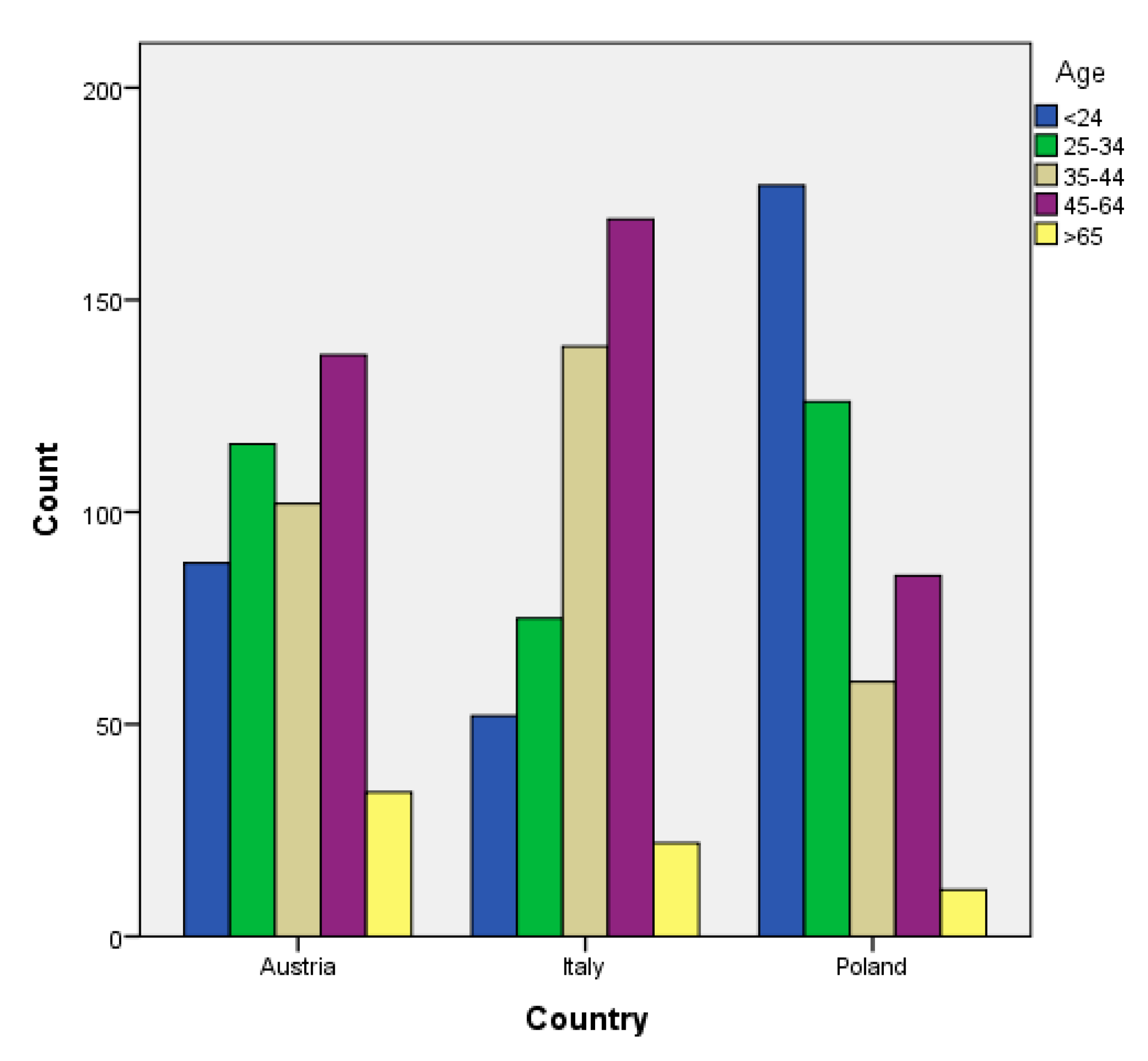
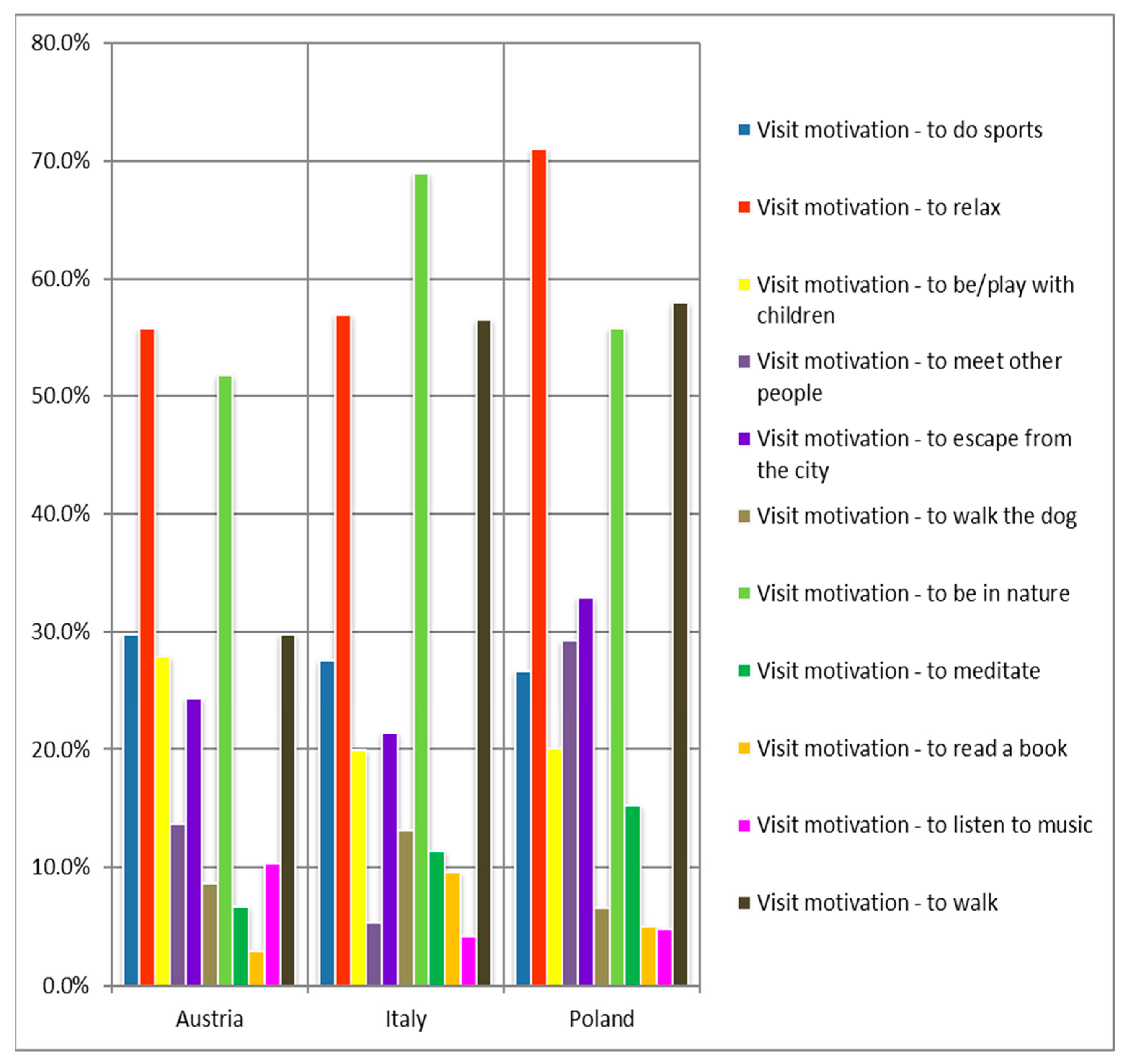
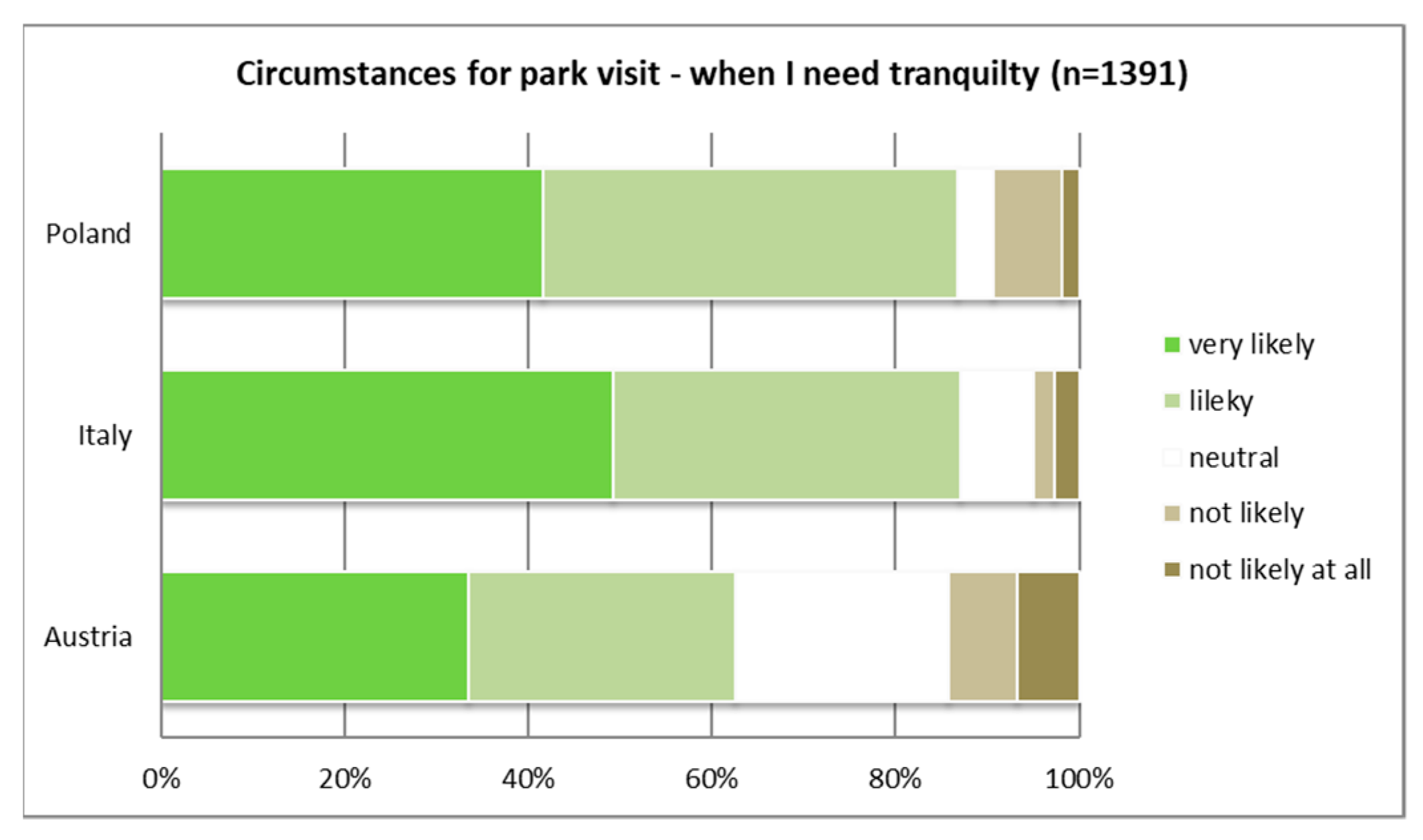
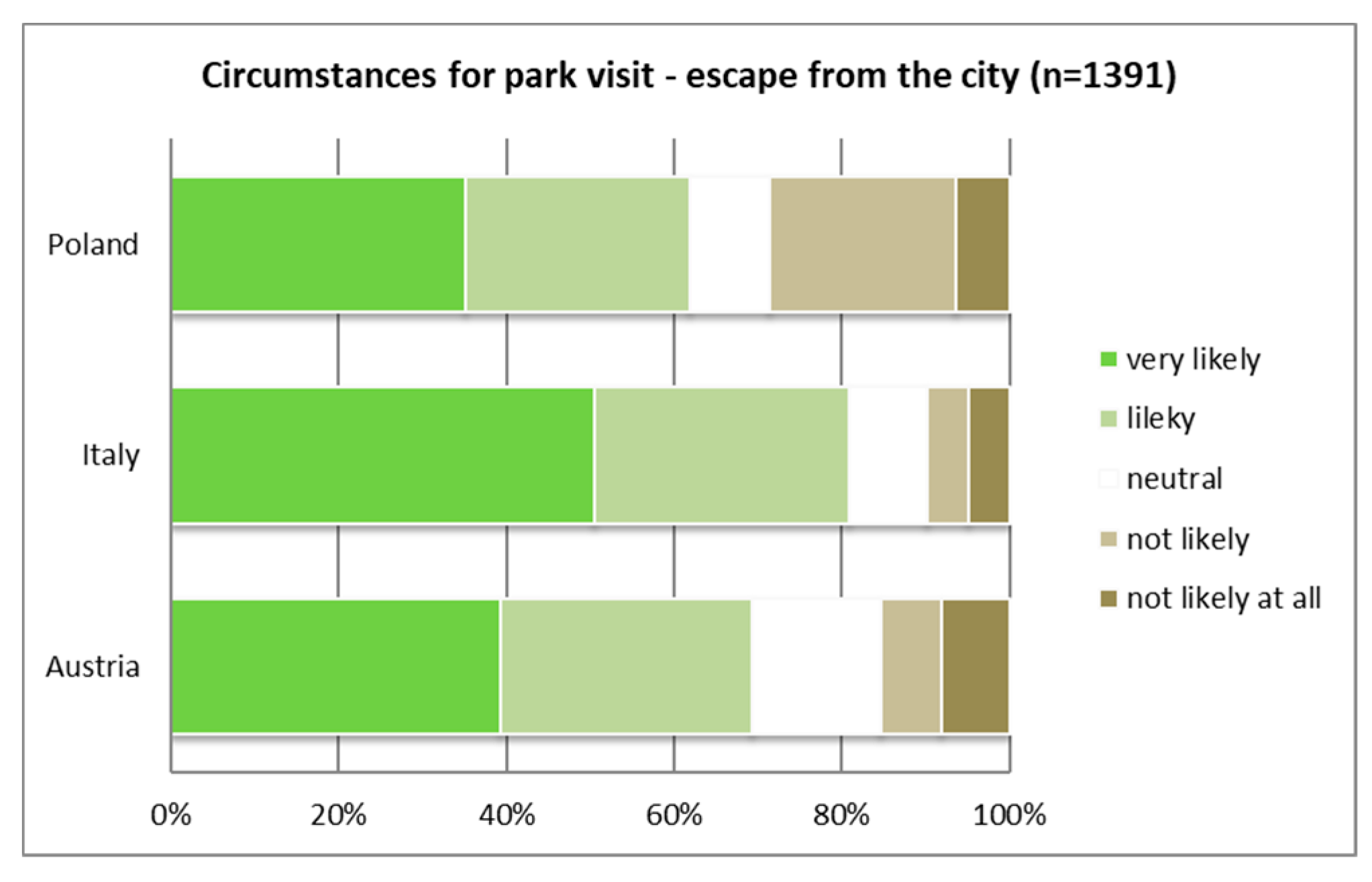
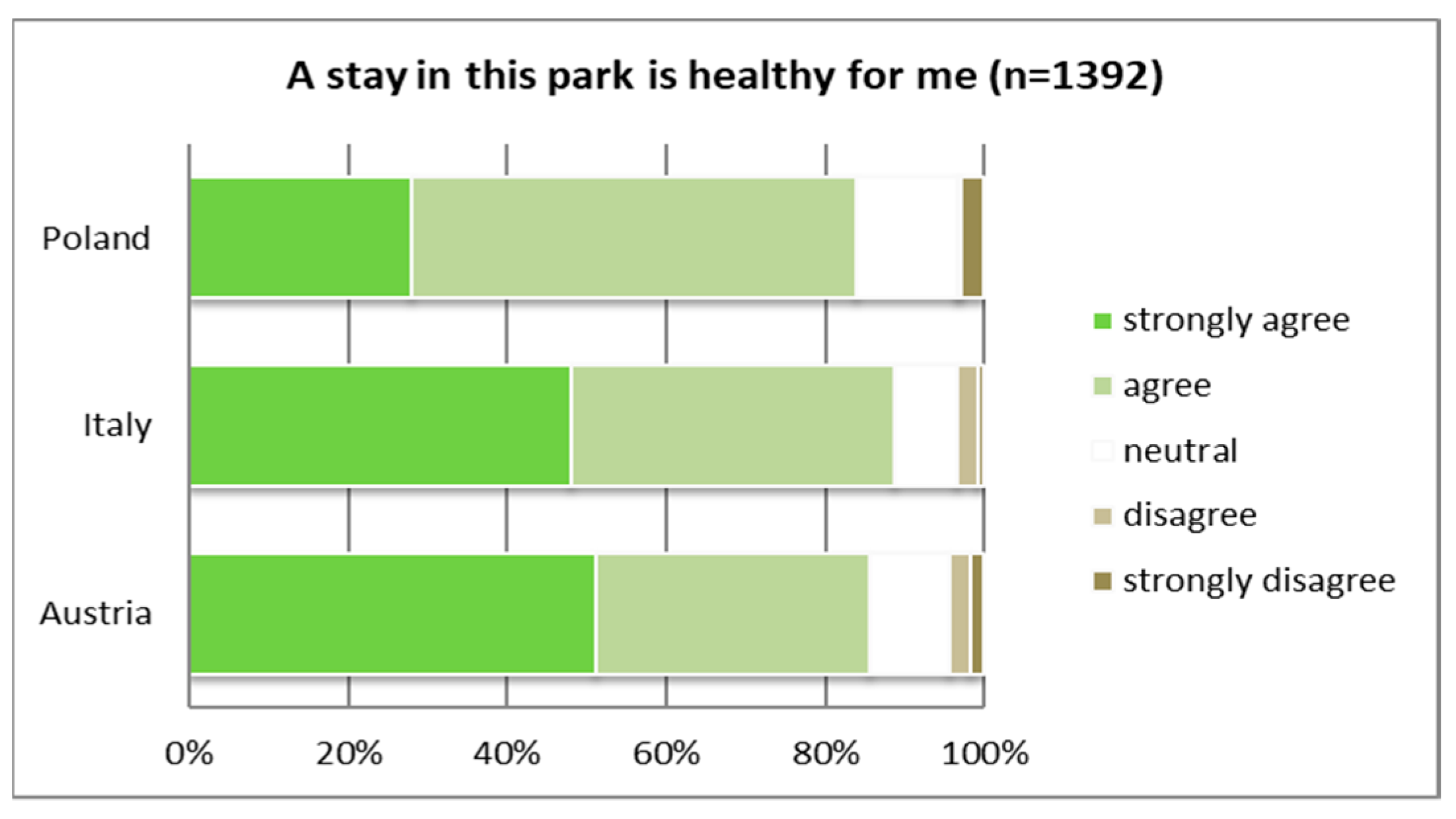
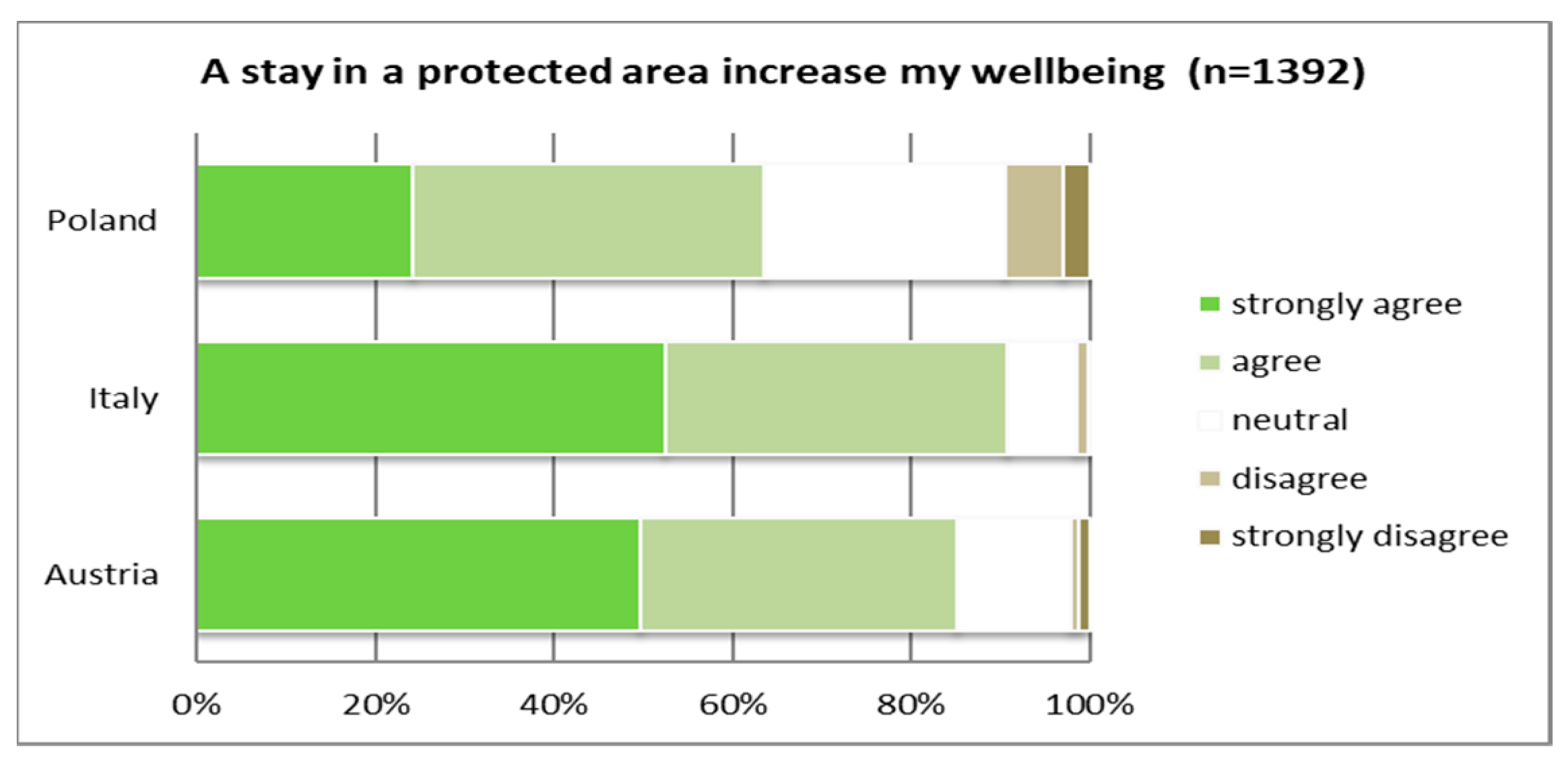
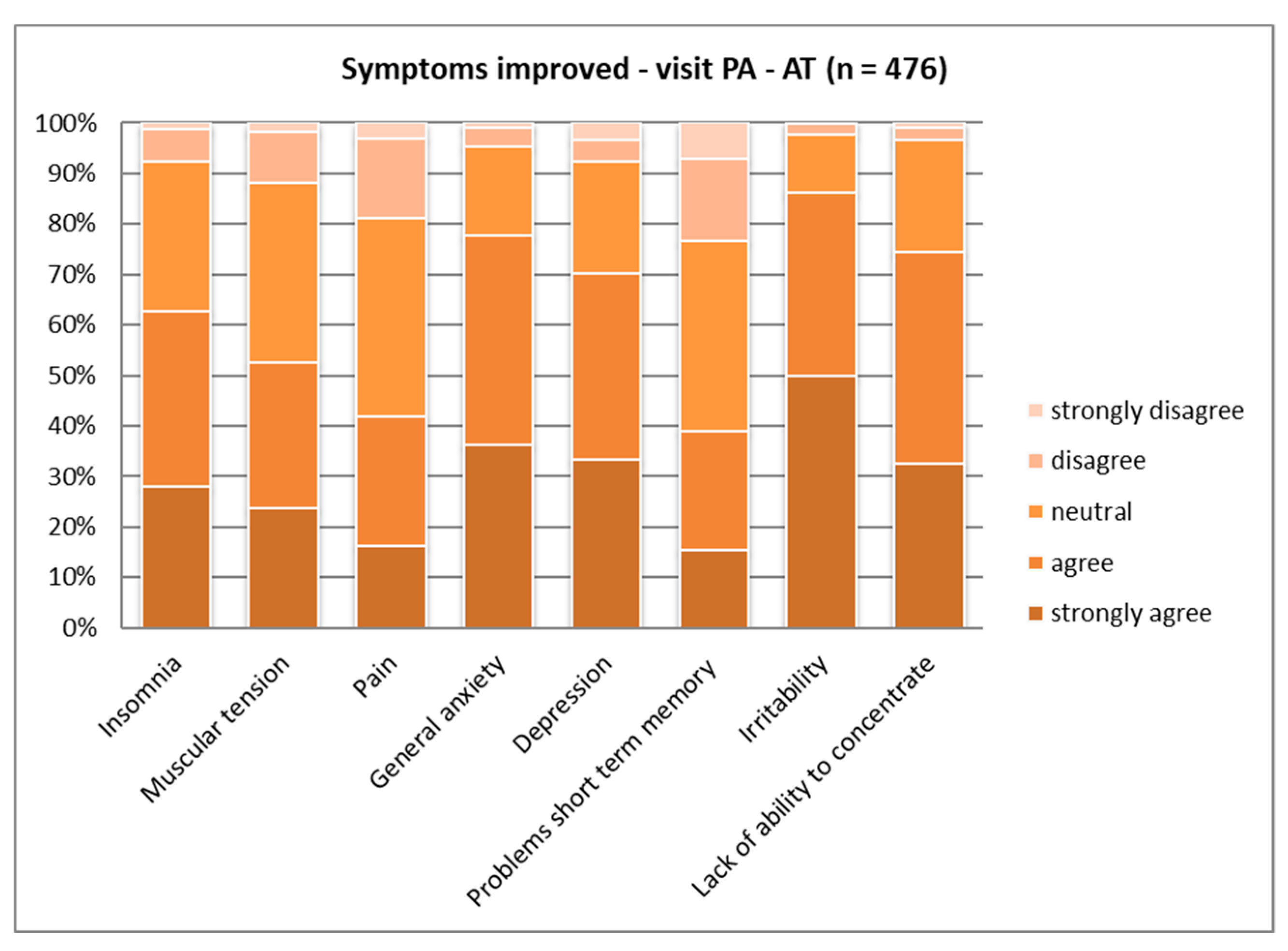
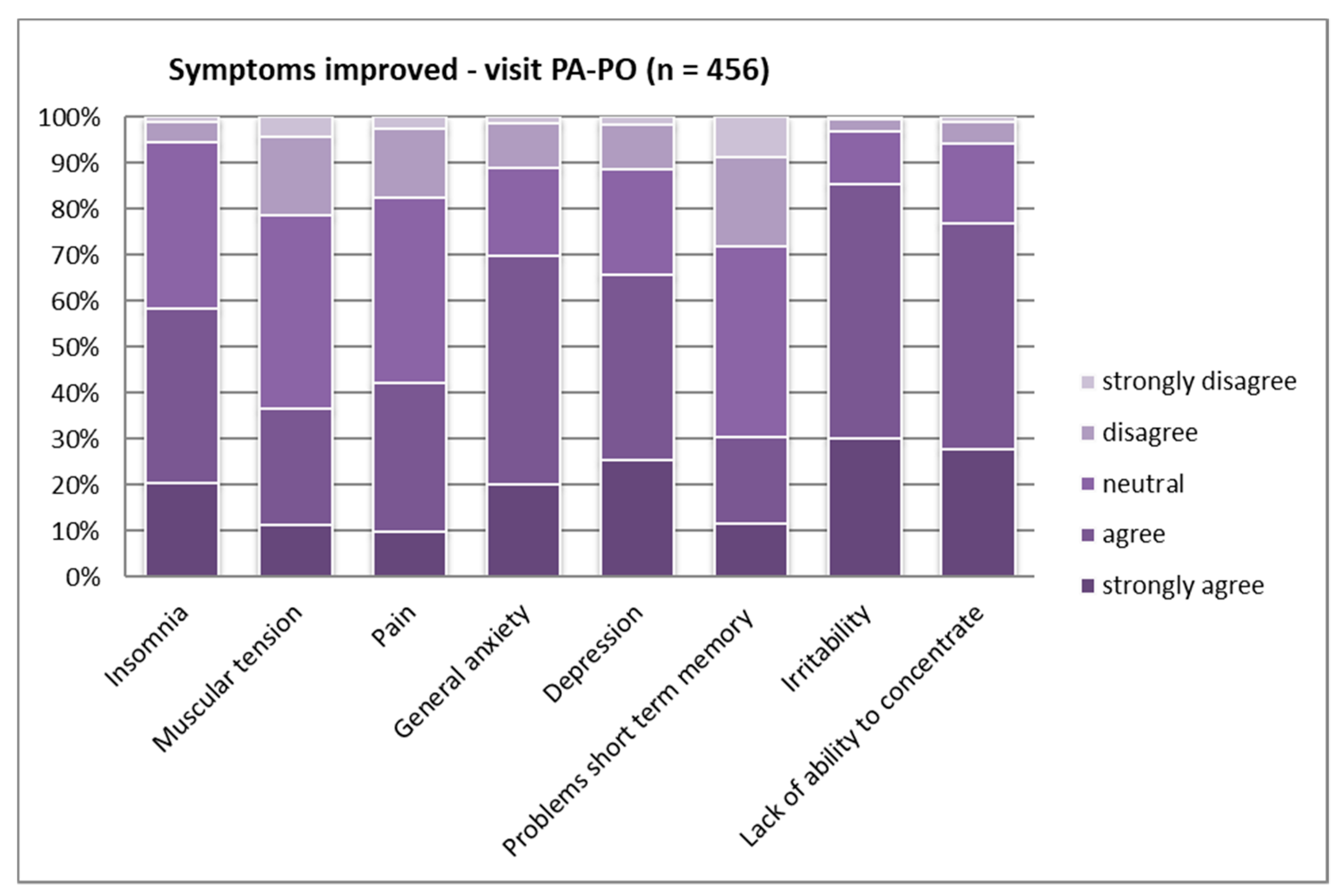
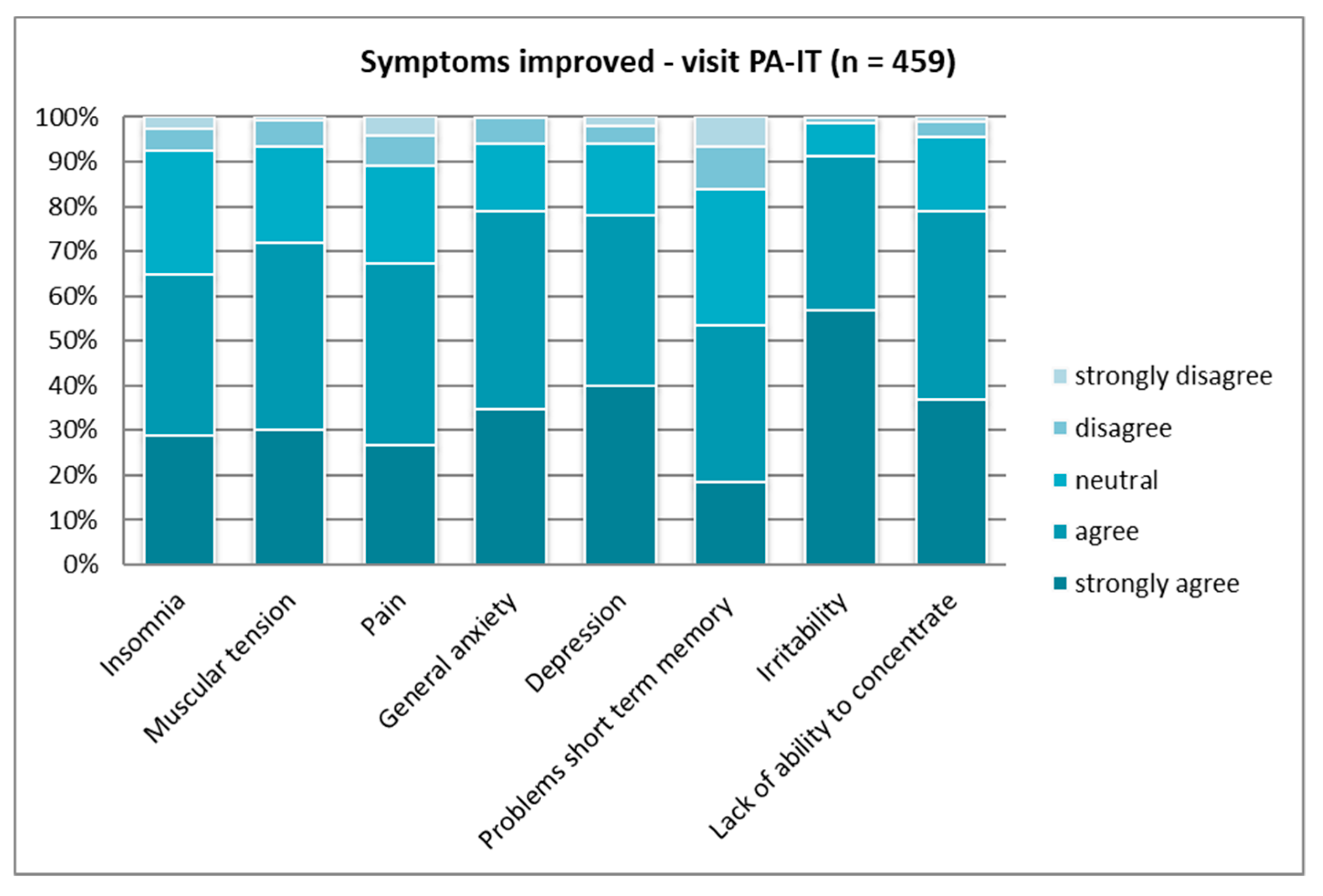
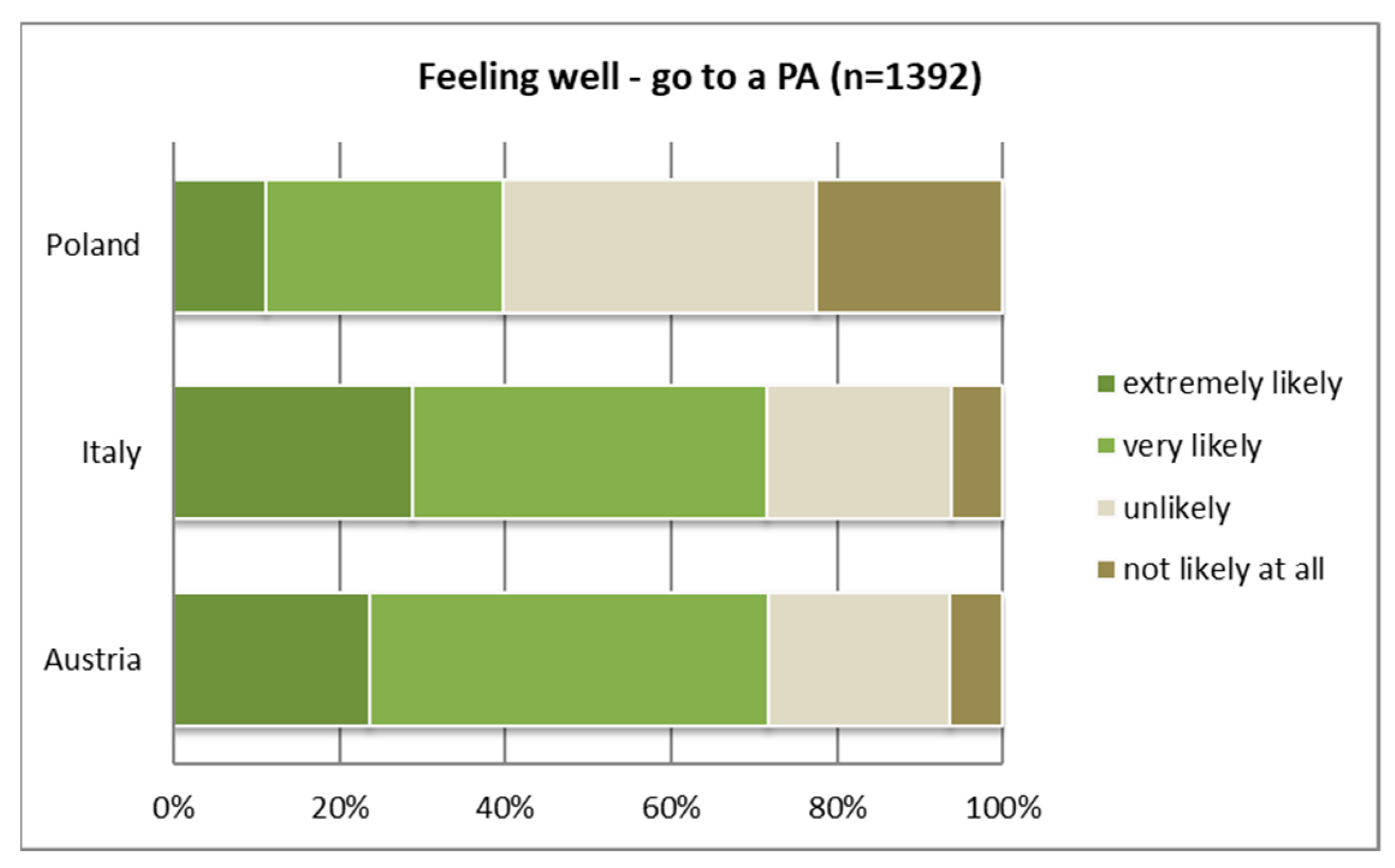
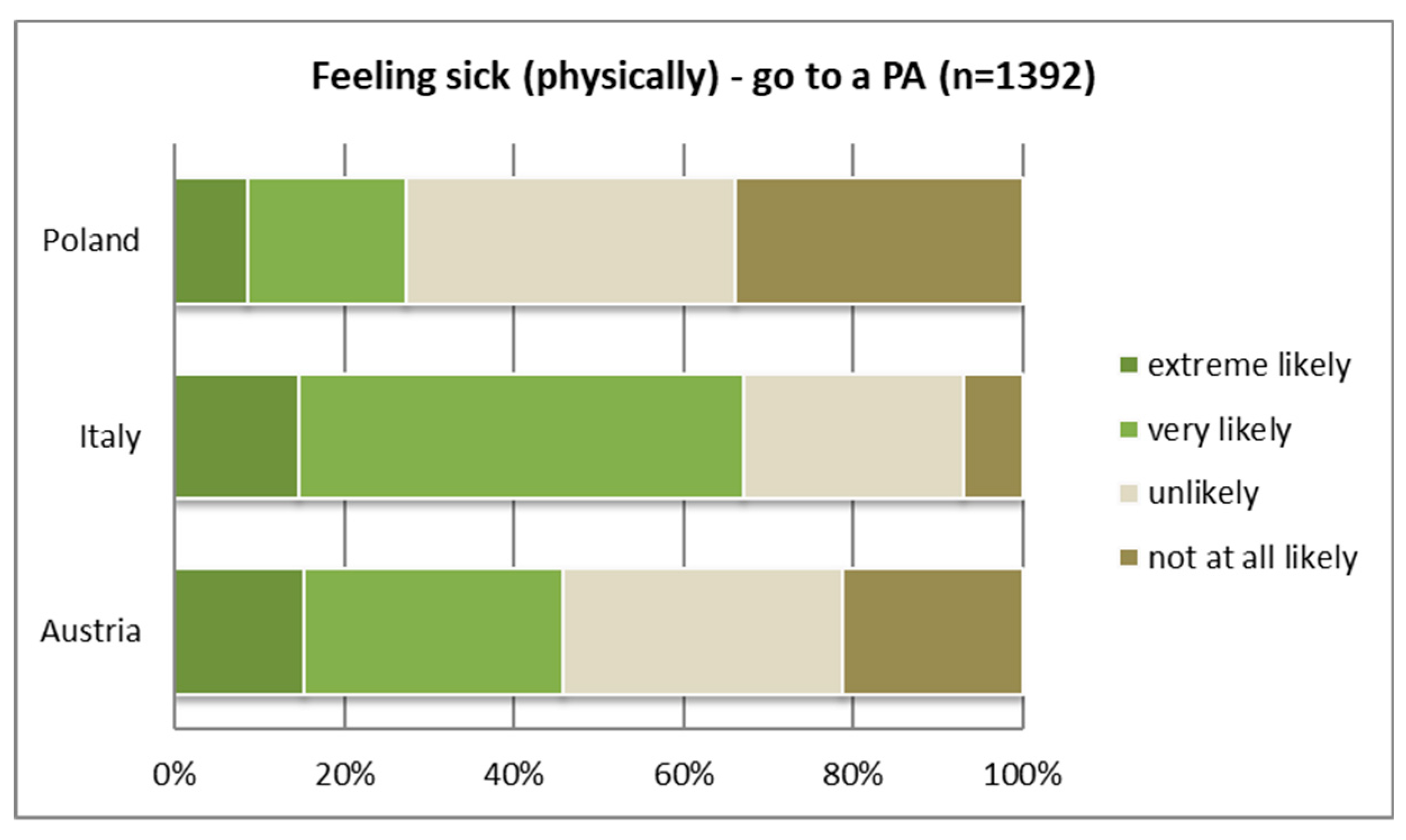
| Study Area | Designation as PA (year) | Size (ha) | Distance to Urban Area(s), ca. (km) | |
|---|---|---|---|---|
| Austria | Nationalpark Donau Auen | 1996 | 9300 | 100 |
| Naturpark Oetscher Tormauren | 1970 | 17,000 | 200 | |
| Biosphere reserve Lungau | 2012 | 15,000 | 300 | |
| Italy | Parco della Val Grande | 1992 | 15,000 | 100 |
| Parco naturale dell’Alpe Veglia e dell’Alpe Devero | 1995 | 9000 | 200 | |
| Riserva della Biosfera “Valle del Ticino” | 1974 | 92,000 | 50 | |
| Poland | National Park Roztocze | 1974 | 8482 | 130 |
| Polesie National Park | 1990 | 9762 | 50 | |
| Janowskie Forests Landscape Park | 1984 | 40,000 | 80 |
| Total Sample | Male | Female | |
|---|---|---|---|
| Austria | count | 226 | 250 |
| % within country | 47.4 | 52.4 | |
| Italy | count | 228 | 229 |
| % within country | 49.9 | 50.1 | |
| Poland | count | 218 | 241 |
| % within country | 46.8 | 52.5 |
| Under Which Circumstances Do You Visit This Park? (Likert Scale Coding: 1—Very Likely, 2—Likely, 3—Neutral, 4—Not Likely, 5—Not Likely at All) | |||||||
|---|---|---|---|---|---|---|---|
| n | Mean | Std. Deviation | Std. Error | ||||
| Circumstances for park visit—when I need tranquility | 0.000 | Austria | 476 | 2.25 | 1.189 | 0.054 | |
| Italy | 457 | 1.71 | 0.907 | 0.042 | |||
| Poland | 459 | 1.83 | 0.949 | 0.044 | |||
| Total | 1392 | 1.94 | 1.050 | 0.028 | |||
| Circumstances for park visit—when I’m feeling well | 0.000 | Austria | 476 | 2.07 | 0.965 | 0.044 | |
| Italy | 457 | 1.86 | 0.863 | 0.040 | |||
| Poland | 459 | 1.92 | 0.830 | 0.039 | |||
| Total | 1392 | 1.95 | 0.893 | 0.024 | |||
| Circumstances for park visit—when I’m feeling bad (emotionally stressed, or depressed) | 0.068 | Austria | 476 | 2.79 | 1.267 | 0.058 | |
| Italy | 457 | 2.56 | 1.254 | 0.059 | |||
| Poland | 459 | 2.58 | 1.142 | 0.053 | |||
| Total | 1392 | 2.65 | 1.226 | 0.033 | |||
| Circumstances for park visit—when I want to escape from the city | 0.000 | Austria | 476 | 2.15 | 1.245 | 0.057 | |
| Italy | 457 | 1.83 | 1.098 | 0.051 | |||
| Poland | 459 | 2.38 | 1.328 | 0.062 | |||
| Total | 1392 | 2.12 | 1.247 | 0.033 | |||
| Reduction of Symptoms (ANOVA) | Sum of Squares | F | Sig. | |
|---|---|---|---|---|
| Irritability | Between Groups | 27.673 | 25.115 | 0.000 |
| Lack of ability to concentrate | Between Groups | 3462 | 2343 | 0.096 |
| Insomnia | Between Groups | 3416 | 1933 | 0.145 |
| Muscular tension | Between Groups | 120.390 | 63.640 | 0.000 |
| Pain | Between Groups | 85.993 | 43.313 | 0.000 |
| General anxiety | Between Groups | 27.731 | 17.508 | 0.000 |
| Depression | Between Groups | 24.006 | 12.431 | 0.000 |
| Short-term memory | Between Groups | 43.930 | 18.126 | 0.000 |
| What Do You Do When You Are Feeling Physically and Mentally Well (Happy—No Stress—Relaxed)? | ||||||||
|---|---|---|---|---|---|---|---|---|
| n | Mean | Std. Deviation | Std. Error | 95% Confidence Interval for Mean | ||||
| Lower Bound | Upper Bound | |||||||
| physically and mentally well—Sleep | 0.000 | Austria | 475 | 2.79 | 0.953 | 0.044 | 2.71 | 2.88 |
| Italy | 457 | 2.67 | 0.951 | 0.045 | 2.58 | 2.76 | ||
| Poland | 456 | 2.85 | 1.149 | 0.054 | 2.75 | 2.96 | ||
| Total | 1388 | 2.77 | 1.023 | 0.027 | 2.72 | 2.83 | ||
| physically and mentally well—Read a book | 0.041 | Austria | 475 | 2.32 | 0.862 | 0.040 | 2.25 | 2.40 |
| Italy | 457 | 2.06 | 0.926 | 0.043 | 1.97 | 2.14 | ||
| Poland | 458 | 2.53 | 0.910 | 0.043 | 2.44 | 2.61 | ||
| Total | 1390 | 2.30 | 0.919 | 0.025 | 2.26 | 2.35 | ||
| physically and mentally well—Watch TV | 0.137 | Austria | 474 | 2.60 | 0.879 | 0.040 | 2.52 | 2.68 |
| Italy | 457 | 2.47 | 0.920 | 0.043 | 2.39 | 2.56 | ||
| Poland | 458 | 2.77 | 0.907 | 0.042 | 2.68 | 2.85 | ||
| Total | 1389 | 2.61 | 0.909 | 0.024 | 2.57 | 2.66 | ||
| physically and mentally well—Sports | 0.000 | Austria | 475 | 1.78 | 0.753 | 0.035 | 1.72 | 1.85 |
| Italy | 456 | 1.77 | 0.789 | 0.037 | 1.69 | 1.84 | ||
| Poland | 458 | 2.22 | 0.902 | 0.042 | 2.13 | 2.30 | ||
| Total | 1389 | 1.92 | 0.842 | 0.023 | 1.88 | 1.97 | ||
| physically and mentally well—Go to a park | 0.000 | Austria | 475 | 2.07 | 0.876 | 0.040 | 1.99 | 2.15 |
| Italy | 457 | 1.81 | 0.790 | 0.037 | 1.74 | 1.88 | ||
| Poland | 454 | 2.28 | 0.939 | 0.044 | 2.19 | 2.36 | ||
| Total | 1386 | 2.05 | 0.890 | 0.024 | 2.01 | 2.10 | ||
| physically and mentally well—Go to a protected area | 0.000 | Austria | 474 | 2.11 | 0.839 | 0.039 | 2.04 | 2.19 |
| Italy | 457 | 2.06 | 0.873 | 0.041 | 1.98 | 2.14 | ||
| Poland | 457 | 2.72 | 0.943 | 0.044 | 2.64 | 2.81 | ||
| Total | 1388 | 2.30 | 0.934 | 0.025 | 2.25 | 2.34 | ||
| physically and mentally well—Take a walk in the city | 0.000 | Austria | 474 | 2.53 | 0.929 | 0.043 | 2.45 | 2.61 |
| Italy | 457 | 2.16 | 0.881 | 0.041 | 2.07 | 2.24 | ||
| Poland | 452 | 2.54 | 1.025 | 0.048 | 2.45 | 2.64 | ||
| Total | 1383 | 2.41 | 0.963 | 0.026 | 2.36 | 2.46 | ||
| physically and mentally well—Go shopping | 0.009 | Austria | 475 | 2.46 | 0.946 | 0.043 | 2.37 | 2.54 |
| Italy | 457 | 2.26 | 0.951 | 0.044 | 2.17 | 2.35 | ||
| Poland | 456 | 2.46 | 1.030 | 0.048 | 2.36 | 2.55 | ||
| Total | 1388 | 2.39 | 0.980 | 0.026 | 2.34 | 2.44 | ||
| physically and mentally well—Listen to music | 0.000 | Austria | 475 | 1.89 | 0.845 | 0.039 | 1.82 | 1.97 |
| Italy | 457 | 1.84 | 0.769 | 0.036 | 1.77 | 1.91 | ||
| Poland | 458 | 2.18 | 0.980 | 0.046 | 2.09 | 2.27 | ||
| Total | 1390 | 1.97 | 0.881 | 0.024 | 1.92 | 2.02 | ||
| What Do You Do When You Are Feeling Physically Sick (Headache-Backache)/Mentally Sick (Stress—Fatigue)? | ||||||||
|---|---|---|---|---|---|---|---|---|
| n | Mean | Std. Deviation | Std. Error | 95% Confidence Interval for Mean | ||||
| Lower Bound | Upper Bound | |||||||
| physically sick—Sleep | 0.000 | Austria | 475 | 1.75 | 0.800 | 0.037 | 1.68 | 1.82 |
| Italy | 457 | 1.72 | 0.824 | 0.039 | 1.65 | 1.80 | ||
| Poland | 459 | 1.87 | 1.024 | 0.048 | 1.78 | 1.97 | ||
| Total | 1391 | 1.78 | 0.889 | 0.024 | 1.74 | 1.83 | ||
| mentally sick—Sleep | 0.000 | Austria | 475 | 1.92 | 0.855 | 0.039 | 1.85 | 2.00 |
| Italy | 457 | 1.86 | 0.879 | 0.041 | 1.77 | 1.94 | ||
| Poland | 459 | 0.00 | 0.000 | 0.000 | 0.00 | 0.00 | ||
| Total | 1391 | 1.27 | 1.137 | 0.030 | 1.21 | 1.33 | ||
| physically sick—Read a book | 0.104 | Austria | 475 | 2.73 | 0.998 | 0.046 | 2.64 | 2.82 |
| Italy | 457 | 2.41 | 0.949 | 0.044 | 2.33 | 2.50 | ||
| Poland | 459 | 2.68 | 0.925 | 0.043 | 2.60 | 2.77 | ||
| Total | 1391 | 2.61 | 0.968 | 0.026 | 2.56 | 2.66 | ||
| mentally sick—Read a book | 0.000 | Austria | 475 | 2.67 | 1.012 | 0.046 | 2.58 | 2.76 |
| Italy | 457 | 2.40 | 0.891 | 0.042 | 2.32 | 2.48 | ||
| Poland | 459 | 0.00 | 0.000 | 0.000 | 0.00 | 0.00 | ||
| Total | 1391 | 1.70 | 1.430 | 0.038 | 1.62 | 1.78 | ||
| physically sick—Watch TV | 0.000 | Austria | 474 | 2.47 | 1.007 | 0.046 | 2.38 | 2.56 |
| Italy | 456 | 2.39 | 0.,950 | 0.044 | 2.30 | 2.48 | ||
| Poland | 459 | 2.47 | 0.885 | 0.041 | 2.39 | 2.56 | ||
| Total | 1389 | 2.45 | 0.949 | 0.025 | 2.40 | 2.50 | ||
| mentally sick—Watch TV | 0.000 | Austria | 475 | 2.40 | 0.974 | 0.045 | 2.31 | 2.49 |
| Italy | 457 | 2.42 | 0.936 | 0.044 | 2.33 | 2.51 | ||
| Poland | 459 | 0.00 | 0.000 | 0.000 | 0.00 | 0.00 | ||
| Total | 1391 | 1.61 | 1.376 | 0.037 | 1.54 | 1.69 | ||
| physically sick—Sports | 0.000 | Austria | 474 | 2.60 | 1.038 | 0.048 | 2.51 | 2.69 |
| Italy | 457 | 2.33 | 0.919 | 0.043 | 2.25 | 2.42 | ||
| Poland | 459 | 2.,66 | 0.982 | 0.046 | 2.57 | 2.75 | ||
| Total | 1390 | 2.53 | 0.991 | 0.027 | 2.48 | 2.58 | ||
| mentally sick—Sports | 0.000 | Austria | 475 | 2.26 | 0.972 | 0.045 | 2.18 | 2.35 |
| Italy | 457 | 2.21 | 0.892 | 0.042 | 2.13 | 2.30 | ||
| Poland | 459 | 0.00 | 0.000 | 0.000 | 0.00 | 0.00 | ||
| Total | 1391 | 1.50 | 1.301 | .035 | 1.43 | 1.57 | ||
| physically sick—Go to a park | 0.000 | Austria | 475 | 2.52 | 0.949 | 0.044 | 2.43 | 2.60 |
| Italy | 457 | 2.18 | 0.863 | 0.040 | 2.10 | 2.26 | ||
| Poland | 459 | 2.59 | 0.871 | 0.041 | 2.51 | 2.67 | ||
| Total | 1391 | 2.43 | 0.912 | 0.024 | 2.38 | 2.48 | ||
| mentally sick—Go to a park | 0.000 | Austria | 475 | 2.27 | 0.893 | 0.041 | 2.19 | 2.35 |
| Italy | 457 | 2.17 | 0.837 | 0.039 | 2.09 | 2.24 | ||
| Poland | 459 | 0.00 | 0.000 | 0.000 | 0.00 | 0.00 | ||
| Total | 1391 | 1.49 | 1.263 | 0.034 | 1.42 | 1.55 | ||
| physically sick—Go to a protected area | 0.000 | Austria | 475 | 2.60 | 0.987 | 0.045 | 2.51 | 2.69 |
| Italy | 457 | 2.25 | 0.789 | 0.037 | 2.18 | 2.32 | ||
| Poland | 459 | 2.97 | 0.964 | 0.045 | 2.88 | 3.05 | ||
| Total | 1391 | 2.61 | 0.963 | 0.026 | 2.56 | 2.66 | ||
| mentally sick—Go to a protected area | 0.000 | Austria | 475 | 2.40 | 0.946 | 0.043 | 2.32 | 2.49 |
| Italy | 457 | 2.24 | 0.762 | 0.036 | 2.17 | 2.31 | ||
| Poland | 459 | 0.00 | 0.000 | 0.000 | 0.00 | 0.00 | ||
| Total | 1391 | 1.55 | 1.301 | .035 | 1.49 | 1.62 | ||
| physically sick—Take a walk in the city | 0.281 | Austria | 474 | 2.95 | 0.959 | 0.,044 | 2.87 | 3.04 |
| Italy | 457 | 2.52 | 0.953 | 0.045 | 2.43 | 2.61 | ||
| Poland | 459 | 3.02 | 1.038 | 0.048 | 2.93 | 3.12 | ||
| Total | 1390 | 2.83 | 1.008 | 0.027 | 2.78 | 2.89 | ||
| mentally sick—Take a walk in the city | 0.000 | Austria | 475 | 2.85 | 0.946 | 0.043 | 2.77 | 2.94 |
| Italy | 457 | 2.52 | 0.948 | 0.044 | 2.43 | 2.61 | ||
| Poland | 459 | 0.00 | 0.000 | 0.000 | 0.00 | 0.00 | ||
| Total | 1391 | 1.80 | 1.489 | 0.040 | 1.72 | 1.88 | ||
| physically sick—Go shopping | 0.000 | Austria | 474 | 3.12 | 0.954 | 0.044 | 3.03 | 3.20 |
| Italy | 457 | 2.74 | 0.960 | 0.045 | 2.65 | 2.83 | ||
| Poland | 459 | 3.03 | 0.948 | 0.044 | 2.94 | 3.12 | ||
| Total | 1390 | 2.96 | 0.967 | 0.026 | 2.91 | 3.01 | ||
| mentally sick—Go shopping | 0.000 | Austria | 475 | 3.,01 | 0.974 | 0.045 | 2.92 | 3.10 |
| Italy | 457 | 2.70 | 0.960 | 0.045 | 2.61 | 2.79 | ||
| Poland | 459 | 0.00 | 0.000 | 0.000 | 0.00 | 0.00 | ||
| Total | 1391 | 1.92 | 1.566 | 0.042 | 1.83 | 2.00 | ||
| physically sick—Listen to music | 0.013 | Austria | 475 | 2.30 | 0.979 | 0.045 | 2.21 | 2.39 |
| Italy | 457 | 2.12 | 0.909 | 0.043 | 2.03 | 2.20 | ||
| Poland | 459 | 2.18 | 0.967 | 0.045 | 2.09 | 2.27 | ||
| Total | 1391 | 2.20 | 0.955 | 0.026 | 2.15 | 2.25 | ||
| mentally sick—Listen to music | 0.000 | Austria | 475 | 2.13 | 0.928 | 0.043 | 2.05 | 2.21 |
| Italy | 457 | 2.03 | 0.865 | 0.040 | 1.95 | 2.11 | ||
| Poland | 459 | 0.00 | 0.000 | 0.000 | 0.00 | 0.00 | ||
| Total | 1391 | 1.39 | 1.225 | 0.033 | 1.33 | 1.46 | ||
© 2019 by the authors. Licensee MDPI, Basel, Switzerland. This article is an open access article distributed under the terms and conditions of the Creative Commons Attribution (CC BY) license (http://creativecommons.org/licenses/by/4.0/).
Share and Cite
Jiricka-Pürrer, A.; Tadini, V.; Salak, B.; Taczanowska, K.; Tucki, A.; Senes, G. Do Protected Areas Contribute to Health and Well-Being? A Cross-Cultural Comparison. Int. J. Environ. Res. Public Health 2019, 16, 1172. https://doi.org/10.3390/ijerph16071172
Jiricka-Pürrer A, Tadini V, Salak B, Taczanowska K, Tucki A, Senes G. Do Protected Areas Contribute to Health and Well-Being? A Cross-Cultural Comparison. International Journal of Environmental Research and Public Health. 2019; 16(7):1172. https://doi.org/10.3390/ijerph16071172
Chicago/Turabian StyleJiricka-Pürrer, Alexandra, Valeria Tadini, Boris Salak, Karolina Taczanowska, Andrzej Tucki, and Giulio Senes. 2019. "Do Protected Areas Contribute to Health and Well-Being? A Cross-Cultural Comparison" International Journal of Environmental Research and Public Health 16, no. 7: 1172. https://doi.org/10.3390/ijerph16071172
APA StyleJiricka-Pürrer, A., Tadini, V., Salak, B., Taczanowska, K., Tucki, A., & Senes, G. (2019). Do Protected Areas Contribute to Health and Well-Being? A Cross-Cultural Comparison. International Journal of Environmental Research and Public Health, 16(7), 1172. https://doi.org/10.3390/ijerph16071172







